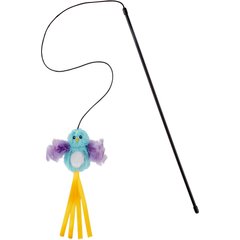Cat Aggression: Fighting, Biting, and Attacking
Aggression is a common behavioral problem in cats.
Because cats are relatively small compared to other animals, they are vulnerable to attack in the wild. This is why even domesticated house cats are genetically programmed to use aggressive behaviors to defend themselves against threats. While useful in the wild, these aggressive behaviors can be problematic for house cats.
Aggressive behaviors in cats often stem from fear, stress, and anxiety, not anger, spite, or other reasons that humans usually use to explain a cat’s aggressive behavior. Understanding and addressing aggressive behaviors can improve a cat’s quality of life and your bond with your cat.
What Are the Signs of Aggression in Cats?
It can be difficult to understand aggression in cats because cat communication in general is pretty complex. Cats use a variety of methods to communicate with other cats, including:
-
Vocal cues
-
Physical contact
-
Chemical messengers such as pheromones
Cats have smaller features than dogs and use more subtle, rapid movements when communicating. But decoding these signs can help identify when a cat is feeling afraid or anxious and potentially on the verge of aggressive behavior.
Body Language
When a cat uses body language to communicate, the main cues will come from the eyes, ears, tail, and overall body posture.
Aggressive, overstimulated cats may have dilated pupils from the rush of adrenaline.
Ears slightly flattened, often known as “airplane ears,” indicate fear or annoyance. Ears flattened completely against the head indicate that the cat is angry and ready to fight.
An upright but stiff tail indicates wariness. When cats tuck their tail under their body, they are feeling afraid or submissive. Angry cats typically have a puffed-up “bottle-brush” tail, and when annoyed, the tail may swish back and forth.
Fearful cats may crouch low to the ground to appear smaller and protect vital organs. Aggressive cats may arch their backs with their hair raised and lean away from the threat, angling their body to appear larger.
Vocal Cues
Vocal cues are sometimes just as important as body language.
Purring can indicate both relaxation and nervousness, as cats use purring to self-soothe when they are feeling stressed.
Chattering is used when watching prey animals, intended to confuse the prey by mimicking their call so the cat can attack. Cats also employ a variety of sounds when they are feeling afraid or angry, such as growling and hissing.
Growling is a loud sound that originates from the throat, while hissing occurs from a burst of air through the mouth. Usually, hissing is used by a cat that is being victimized and feels fearful to scare off a larger, more antagonistic threat, as it mimics the sound of a snake hissing. Growling can also be used to banish a threat, but it implies a more dominant, possessive attitude.
Physical Contact
Cats may also resort to physical contact to communicate. Aggressive or fearful cats may pounce on, bite, or scratch other cats, animals, or humans. Cats that are afraid or angry will typically hide or keep their distance.
Chemical Cues
Chemical cues can include pheromones, oils from scent glands, and urine.
Cats will rub on other cats, animals, and humans to transfer scent and claim ownership. Cats also rub on inanimate objects in the home for the same reason, establishing their territory. Urine spraying is also used to mark territory, especially if the cat spends any time outdoors. Marking in the house can occur in response to another cat in the area or some source of stress.
Signs of Defensive vs. Offensive Aggression in Cats
When a cat displays aggressive behavior, they will often use a combination of signals to indicate their emotional state. These signals will change depending on whether they are the victim (defensive aggression) or attacker (offensive aggression).
Defensive aggression signs include crouching low to the ground to protect the cat’s underside; hissing and baring the teeth so that the threat backs away and the cat can avoid confrontation; tucking their tail under the body; or standing their fur on end to create to intimidate and scare off a threat.
Offensive aggression signs include swatting at other animals or people, blocking off doorways or passages to show dominance, growling, swishing the tail rapidly side to side, chasing and attacking other animals or people, and standing up with their back arched and body turned sideways to seem larger.
Shop Toys, Training and More
- Feliway Optimum Enhanced Calming 30 Day Diffuser for Cats$29.99Chewy Price
- Purina Pro Plan Veterinary Diets Calming Care Cat Supplement, 30 count$33.99Chewy Price
- Nutramax Solliquin Soft Chew Calming Behavioral Health Supplement for Small/Medium Dogs & Cats, 75 count$19.99Chewy Price
- Frisco Bird with Feathers Teaser Wand Cat Toy with Catnip, Blue$5.99Chewy Price
Types of Cat Aggression
There are several types of cat aggression, and these give some context to a cat’s aggressive behavior in a specific situation:
-
Play aggression occurs when cats that haven’t been properly socialized are overstimulated during positive play interactions. This can lead to biting, scratching, and pouncing inappropriately on humans or animal playmates.
-
Fear aggression can happen when a cat encounters an unfamiliar animal, person, or noise, or when the cat is placed in an environment where they previously had an unpleasant experience, causing the cat to react in a violent manner.
-
Petting-induced aggression can be shown when a cat is overstimulated from too much petting or is being petted against their will.
-
Pain-induced aggression happens when a cat feels physically uncomfortable and behaves hostilely toward any touch or movement of their body that worsens their discomfort.
-
Territorial aggression occurs when a human or animal, especially during a new introduction, tries to enter the cat’s established area within a household. The cat may interpret this as a challenge and lash out to defend their domain.
-
Redirected aggression happens when a cat is presented with a threatening stimulus, such as a loud noise that’s far away or a new cat in the neighborhood, and they can’t address or attack the stimulus directly. Instead, the cat will display aggressive behaviors toward human or animal members of the household.
-
Status-induced aggression may happen when a cat wants to establish dominance in the household hierarchy, and this can be directed both at other animals and at people in the household.
-
Maternal aggression may occur in female cats that have recently given birth. They may react negatively toward any individual that approaches their litter.
-
Inter-cat aggression usually occurs when male cats near social maturity (between 2 and 4 years of age) attempt to establish a social order. Hormones may play a role in this behavior, which can also occur between female cats, though more rarely.
Are Certain Cat Breeds More Aggressive?
While it’s possible for any cat to display aggressive tendencies, certain breeds are more prone to aggression than others.
Abyssinian and Siamese cats are a couple of breeds more predisposed to aggression. Ragdoll, Sphynx, Burmese, and Maine Coon breeds are generally more easygoing. Falling into the middle of the spectrum are the Domestic Shorthair and Domestic Longhair.
Of course, breed is just one factor in determining aggression in cats, and there are plenty of examples of Siamese cats that are naturally easygoing and Burmese cats that are aggressive. However, understanding breed influences on aggression can be informative in determining the best way to manage aggressive behaviors.
Why Is My Cat Suddenly Aggressive?
Some types of aggression, such as fear aggression, can take months to develop in cats. Other types may appear suddenly. One of the most common causes of sudden aggression in cats is pain, which could be related to dental issues, trauma and injuries, arthritis, or infections.
There are also plenty of other causes for sudden aggression in cats. Here are some examples of common reasons:
-
Cognitive decline in older cats or neurological issues in cats of any age—epilepsy and brain tumors, for example—can lead to sudden aggressive behaviors.
-
Moving to a new environment or introducing new cats or people into a familiar environment can trigger sudden aggression.
-
Cats that have been exposed repeatedly to stressful situations and have shown no previous reaction may lash out aggressively when exposed to the stressful situation again.
-
Cats may tolerate petting to a certain degree and become suddenly aggressive when they no longer want to be petted or when a certain part of their body is touched, such as the base of the tail or paws.
-
Female cats in heat may also act aggressively due to hormonal fluctuations.
-
Young, intact male cats may become suddenly aggressive when introduced to other young, intact male cats in their territory, triggering status-induced aggressive episodes.
In any case, sudden aggression in cats should be addressed with a veterinary visit as soon as possible to rule out potential medical concerns.
Why Is My Cat Aggressive at Night?
There are a variety of reasons why a cat may show increased aggression at night. The daily change in light levels around twilight and later can be stressful for some cats, and stress and anxiety can exacerbate aggressive behavior.
Some cats may also be more alert at night, since cats are crepuscular (more active at dawn and dusk, when light levels are low). As such, sights, sounds, and smells can be more triggering for cats during this time, resulting in an increase in aggression.
How to Calm Aggressive Cats
Calming aggressive cats often means taking a multifaceted approach.
Mild to Moderate Cat Aggression
For cats that fight frequently with each other, the Feliway MultiCat pheromone diffuser can be useful in creating a positive emotional environment. Feliway Optimum may be a good choice for cats that are frequently aggressive toward people. Feliway diffusers are effective in an area measuring up to 700 square feet and should not be placed near litter boxes.
Calming supplements such as Solliquin, Zylkene, and Calming Care probiotic powder are designed for daily use and may be given to aggressive cats to help regulate their reactions to other cats or to people. It can take up to six weeks for these products to start to have an effect.
Feliway Classic spray can be helpful for pre-treating carriers, towels, or mats before veterinary visits or grooming tasks such as brushing and nail trims.
Moderate to Severe Cat Aggression
In moderate to severe cases of aggression, you can work with your vet and/or behaviorist to combine medication with behavioral methods. Prescription medications such as gabapentin, fluoxetine, and alprazolam may be needed to calm a cat down to a manageable level, and you can try behavioral therapies such as desensitization.
Desensitization involves carefully assessing and correcting your cat’s behavior in a controlled environment. The idea is to ignore inappropriate behaviors and reward appropriate ones in a timely manner.
For example, if your cat is aggressive toward visitors, desensitization would involve:
-
Determining the distance from the visitor at which your cat becomes aggressive
-
Starting 5–10 feet farther away from the visitor than that distance
-
Slowly bringing the visitor closer while rewarding your cat for showing calm, relaxed behaviors
This process can take weeks or months until they are able to remain calm around visitors.
Play Aggression and Boredom
Cats that fight due to play aggression and attack people out of boredom, under-stimulation, or under-socialization can benefit immensely from increased enrichment and interactive playtime. This includes appropriate toys, perches installed near windows, leash walks, or spending time on “catios,” screened-in outdoor spaces that give cats fresh air and a chance to see wildlife.
What Not to Do With Aggressive Cats
To avoid injury, be sure to keep your hands, feet, arms, and legs away from a cat when they are acting aggressively.
Never use physical or other forms of punishment to address aggression in cats. This includes both hitting and using spray bottles to squirt water on cats. Loud, sustained shouting is also counterproductive for treating aggression. These tactics can increase fear and anxiety in cats, which can worsen the aggression in the long run.
Do not praise, reward, or comfort a cat that is acting aggressively. This will only reinforce and reward the aggressive behavior.
The bottom line is that most aggressive behaviors in cats can be managed to an acceptable level with proper tools and by working consistently with a veterinary behaviorist or certified International Association of Animal Behavior Consultants (IAABC) professional.
In some instances, two cats may have incompatible personalities that can only be addressed to a certain degree, and rehoming may be necessary at that point. Some cats may always be aggressive about being touched in an area where they once experienced pain, such as with severe leg or back injuries.
If older cats develop aggression due to cognitive decline, the aggression may get worse as they continue to age. These harder-to-manage cases make it particularly important to work closely with a veterinarian to ease the aggression and to find workable solutions if it cannot be completely eliminated.
Featured image: iStock.com/GluePromsiri




